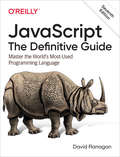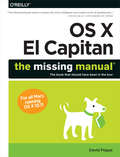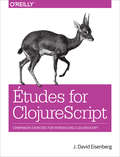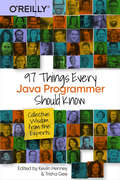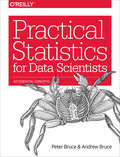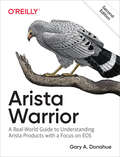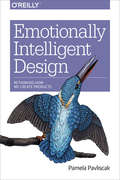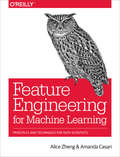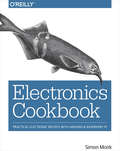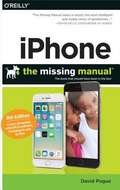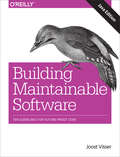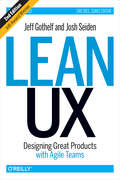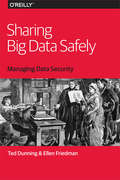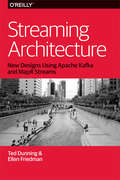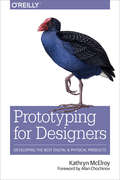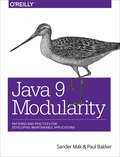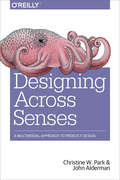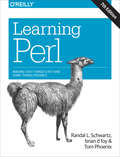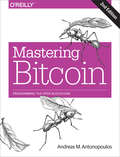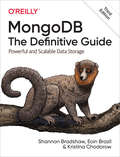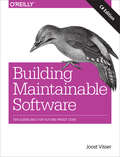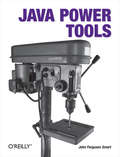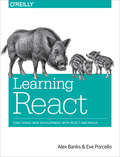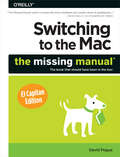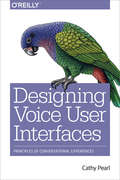- Table View
- List View
JavaScript: Master the World's Most-Used Programming Language (Definitive Guide Ser.)
by David FlanaganFor web developers and other programmers interested in using JavaScript, this bestselling book provides the most comprehensive JavaScript material on the market. The seventh edition represents a significant update, with new information for ECMAScript 2020, and new chapters on language-specific features.JavaScript: The Definitive Guide is ideal for experienced programmers who want to learn the programming language of the web, and for current JavaScript programmers who want to master it.
OS X El Capitan: The Missing Manual
by David PogueWith El Capitan, Apple brings never-before-seen features to OS X--like a split-screen desktop, improved window controls, and amazing graphics. The new edition of David Pogue's #1 bestselling Mac book shows you how to use key new features such as swiping gestures, Notes, a new Spotlight search system, the Safari pinning feature, and Split View.Missing Manuals creator David Pogue is one of the most widely recognized technology authors in the world. A former New York Times technology columnist, he founded and now produces videos for Yahoo Tech.
Etudes for ClojureScript
by J. David EisenbergA short composition that provides practice material for a particular musical skill is called an étude. In this hands-on book, you'll find more than 30 études to help you practice ClojureScript skills for specific programming areas, ranging from functions and variables to asynchronous processing. Each of these small projects includes a description of a program that you will compose (write) in ClojureScript.Though not as difficult as their musical counterparts, these programming études will help you stretch beyond the material and examples that you find in most ClojureScript books or online references. One chapter features études for an open-ended project that will help you put together what you've learned. Solutions to each étude are revealed in the appendix.Programming areas include:Working with functions and variables with def and letInteracting with JavaScript and web pages, using several librariesLists, vectors, and higher-order map, filter, and reduce functionsData mapping with ClojureScriptUsing different ClojureScript libraries to program with ReactAdding, subtracting, multiplying, and dividing rational and complex numbers with defprotocol and defrecordAsynchronous processing with core.async
97 Things Every Java Programmer Should Know: Collective Wisdom from the Experts
by Kevlin Henney Trisha GeeIf you want to push your Java skills to the next level, this book provides expert advice from Java leaders and practitioners. You’ll be encouraged to look at problems in new ways, take broader responsibility for your work, stretch yourself by learning new techniques, and become as good at the entire craft of development as you possibly can. <P><P>Edited by Kevlin Henney and Trisha Gee, 97 Things Every Java Programmer Should Know reflects lifetimes of experience writing Java software and living with the process of software development. Great programmers share their collected wisdom to help you rethink Java practices, whether working with legacy code or incorporating changes since Java 8. <P><P>A few of the 97 things you should know: <P><P>"Behavior Is Easy, State Is Hard"—Edson Yanaga <P><P>“Learn Java Idioms and Cache in Your Brain”—Jeanne Boyarsky <P><P>“Java Programming from a JVM Performance Perspective”—Monica Beckwith <P><P>"Garbage Collection Is Your Friend"—Holly K Cummins <P><P>“Java's Unspeakable Types”—Ben Evans <P><P>"The Rebirth of Java"—Sander Mak <P><P>“Do You Know What Time It Is?”—Christin Gorman
Practical Statistics for Data Scientists: 50 Essential Concepts
by Peter Bruce Andrew BruceStatistical methods are a key part of of data science, yet very few data scientists have any formal statistics training. Courses and books on basic statistics rarely cover the topic from a data science perspective. This practical guide explains how to apply various statistical methods to data science, tells you how to avoid their misuse, and gives you advice on what's important and what's not.Many data science resources incorporate statistical methods but lack a deeper statistical perspective. If you’re familiar with the R programming language, and have some exposure to statistics, this quick reference bridges the gap in an accessible, readable format.With this book, you’ll learn:Why exploratory data analysis is a key preliminary step in data scienceHow random sampling can reduce bias and yield a higher quality dataset, even with big dataHow the principles of experimental design yield definitive answers to questionsHow to use regression to estimate outcomes and detect anomaliesKey classification techniques for predicting which categories a record belongs toStatistical machine learning methods that “learn” from dataUnsupervised learning methods for extracting meaning from unlabeled data
Arista Warrior: Arista Products with a Focus on EOS (Oreilly And Associate Ser.)
by Gary A. DonahueArista Networks has become a key player when it comes to software-driven cloud networking solutions for large data center storage and computing environments. In this updated edition of Arista Warrior, renowned consultant and technical author Gary Donahue Network Arista Networks has become a key player when it comes to software-driven cloud networking solutions for large data center, storage, and computing environments, and with their continued expansion and growth since the first edition was released, this book is a welcome update. In this updated edition of Arista Warrior, renowned trainer, consultant, and technical author Gary A. Donahue (Network Warrior) provides an in-depth, objective guide to Arista’s products explains why its network switches, software products, and Extensible Operating System (EOS) are so effective.Anyone with a CCNA or equivalent knowledge will benefit from this book, especially entrenched administrators, engineers, or architects tasked with building an Arista network. Is Arista right for your network? Pick up this in-depth guide and find out.In addition to the topics covered in the first edition, this book also includes:Configuration Management: Config sessions, config replace, etc.CloudVision: Arista’s management, workload orchestration, workflow automation, configuration, and telemetry toolVXLAN: Layer-2 overlay networkingFlexRoute: Two million routes in hardwareTap Aggregation: Make your switch or blade into a Tap Aggregation deviceAdvanced Mirroring: Mirror to a port-channel or even the CPUNetwork Design: A quick overview of the Arista recommended network designsvEOS: Arista’s Extensible Operating System in a VM with step-by-step instructionscEOS: Arista’s EOS in a container with exampleseAPI: Arista’s fabulous extended Application Programmable Interface
Emotionally Intelligent Design: Rethinking How We Create Products
by Pamela PavliscakAs technology becomes deeply integrated into every aspect of our lives, we’ve begun to expect more emotionally intelligent interactions. But smartphones don’t know if we’re having a bad day, and cars couldn’t care less about compassion. Technology is developing more IQ, but it still lacks EQ.In this book, Pamela Pavliscak—design researcher and advisor to Fortune 500 companies—explores new research about emotion, new technology that engages emotion, and new emotional design practices. Drawing on her own research and the latest thinking in psychology, neuroscience, and behavioral economics, Pamela shows you how design can help promote emotional well-being.You’ll learn:How design has transformed emotion and how tech is transforming it againNew principles for merging emotional intelligence and design thinkingHow to use a relationship model for framing product interactions and personalityMethods for blending well-being interventions with design patternsHow emotional resonance can guide designers toward ethical futuresImplications of emotionally intelligent technology as it scales from micro- to mega-emotional spheres
Feature Engineering for Machine Learning: Principles and Techniques for Data Scientists
by Alice Zheng Amanda CasariFeature engineering is a crucial step in the machine-learning pipeline, yet this topic is rarely examined on its own. With this practical book, you’ll learn techniques for extracting and transforming features—the numeric representations of raw data—into formats for machine-learning models. Each chapter guides you through a single data problem, such as how to represent text or image data. Together, these examples illustrate the main principles of feature engineering.Rather than simply teach these principles, authors Alice Zheng and Amanda Casari focus on practical application with exercises throughout the book. The closing chapter brings everything together by tackling a real-world, structured dataset with several feature-engineering techniques. Python packages including numpy, Pandas, Scikit-learn, and Matplotlib are used in code examples.You’ll examine:Feature engineering for numeric data: filtering, binning, scaling, log transforms, and power transformsNatural text techniques: bag-of-words, n-grams, and phrase detectionFrequency-based filtering and feature scaling for eliminating uninformative featuresEncoding techniques of categorical variables, including feature hashing and bin-countingModel-based feature engineering with principal component analysisThe concept of model stacking, using k-means as a featurization techniqueImage feature extraction with manual and deep-learning techniques
Electronics Cookbook: Practical Electronic Recipes with Arduino and Raspberry Pi
by Simon MonkIf you’re among the many hobbyists and designers who came to electronics through Arduino and Raspberry Pi, this cookbook will help you learn and apply the basics of electrical engineering without the need for an EE degree. Through a series of practical recipes, you’ll learn how to solve specific problems while diving into as much or as little theory as you’re comfortable with.Author Simon Monk (Raspberry Pi Cookbook) breaks down this complex subject into several topics, from using the right transistor to building and testing projects and prototypes. With this book, you can quickly search electronics topics and go straight to the recipe you need. It also serves as an ideal reference for experienced electronics makers.This cookbook includes:Theoretical concepts such as Ohm’s law and the relationship between power, voltage, and currentThe fundamental use of resistors, capacitors and inductors, diodes, transistors and integrated circuits, and switches and relaysRecipes on power, sensors and motors, integrated circuits, and radio frequency for designing electronic circuits and devicesAdvice on using Arduino and Raspberry Pi in electronics projectsHow to build and use tools, including multimeters, oscilloscopes, simulations software, and unsoldered prototypes
iPhone: The Missing Manual
by David PogueWith multitasking and more than a 100 other new features, iPhone 4.0 is a real treat, cooked up with Apple's traditional secret sauce of simplicity, intelligence, and whimsy. iPhone: The Missing Manual gives you a guided tour of everything the new iPhone has to offer, with lots of tips, tricks, and surprises. Learn how to make calls and play songs by voice control, take great photos, keep track of your schedule, and much more with complete step-by-step instructions and crystal-clear explanations by iPhone master David Pogue. Whether you have a brand-new iPhone, or want to update an earlier model with the iPhone 4.0 software, this beautiful full-color book is the best, most objective resource available. Use it as a phone -- learn the basics as well as time-saving tricks and tips for contact searching, texting, and more Treat it as an iPod -- master the ins and outs of iTunes, and listen to music, upload and view photos, and fill the iPhone with TV shows and movies Take the iPhone online -- make the most of your online experience to browse the Web, read and compose email, use social networks, or send photos and audio files Go beyond the iPhone -- learn how to use the App Store, and how to multitask between your apps, organize them in folders, and read ebooks in iBooks Unlock the full potential of your iPhone -- with the book that should have been in the box.
Building Maintainable Software, Java Edition
by Pascal Van Eck Sylvan Rigal Joost Visser Gijs Wijnholds Rob van der LeekHave you ever felt frustrated working with someone else's code? Difficult-to-maintain source code is a big problem in software development today, leading to costly delays and defects. Be part of the solution. With this practical book, you'll learn 10 easy-to-follow guidelines for delivering Java software that's easy to maintain and adapt. These guidelines have been derived from analyzing hundreds of real-world systems.Written by consultants from the Software Improvement Group (SIG), this book provides clear and concise explanations, with advice for turning the guidelines into practice. Examples for this edition are written in Java, while our companion C# book provides workable examples in that language.Write short units of code: limit the length of methods and constructorsWrite simple units of code: limit the number of branch points per methodWrite code once, rather than risk copying buggy codeKeep unit interfaces small by extracting parameters into objectsSeparate concerns to avoid building large classesCouple architecture components looselyBalance the number and size of top-level components in your codeKeep your codebase as small as possibleAutomate tests for your codebaseWrite clean code, avoiding "code smells" that indicate deeper problems
Lean UX: Designing Great Products with Agile Teams
by Josh Seiden Jeff GothelfUX design has traditionally been deliverables-based. Wireframes, site maps, flow diagrams, content inventories, taxonomies, mockups helped define the practice in its infancy.Over time, however, this deliverables-heavy process has put UX designers in the deliverables business. Many are now measured and compensated for the depth and breadth of their deliverables instead of the quality and success of the experiences they design. Designers have become documentation subject matter experts, known for the quality of the documents they create instead of the end-state experiences being designed and developed.So what's to be done? This practical book provides a roadmap and set of practices and principles that will help you keep your focus on the the experience back, rather than the deliverables.Get a tactical understanding of how to successfully integrate Lean and UX/DesignFind new material on business modeling and outcomes to help teams work more strategicallyDelve into the new chapter on experiment designTake advantage of updated examples and case studies
Sharing Big Data Safely
by Ted Dunning Ellen FriedmanMany big data-driven companies today are moving to protect certain types of data against intrusion, leaks, or unauthorized eyes. But how do you lock down data while granting access to people who need to see it? In this practical book, authors Ted Dunning and Ellen Friedman offer two novel and practical solutions that you can implement right away.Ideal for both technical and non-technical decision makers, group leaders, developers, and data scientists, this book shows you how to:Share original data in a controlled way so that different groups within your organization only see part of the whole. You'll learn how to do this with the new open source SQL query engine Apache Drill.Provide synthetic data that emulates the behavior of sensitive data. This approach enables external advisors to work with you on projects involving data that you can't show them.If you're intrigued by the synthetic data solution, explore the log-synth program that Ted Dunning developed as open source code (available on GitHub), along with how-to instructions and tips for best practice. You'll also get a collection of use cases.Providing lock-down security while safely sharing data is a significant challenge for a growing number of organizations. With this book, you'll discover new options to share data safely without sacrificing security.
Streaming Architecture: New Designs Using Apache Kafka and MapR Streams
by Ellen Friedman Ted DunningMore and more data-driven companies are looking to adopt stream processing and streaming analytics. With this concise ebook, you'll learn best practices for designing a reliable architecture that supports this emerging big-data paradigm.Authors Ted Dunning and Ellen Friedman (Real World Hadoop) help you explore some of the best technologies to handle stream processing and analytics, with a focus on the upstream queuing or message-passing layer. To illustrate the effectiveness of these technologies, this book also includes specific use cases.Ideal for developers and non-technical people alike, this book describes:Key elements in good design for streaming analytics, focusing on the essential characteristics of the messaging layerNew messaging technologies, including Apache Kafka and MapR Streams, with links to sample codeTechnology choices for streaming analytics: Apache Spark Streaming, Apache Flink, Apache Storm, and Apache ApexHow stream-based architectures are helpful to support microservicesSpecific use cases such as fraud detection and geo-distributed data streamsTed Dunning is Chief Applications Architect at MapR Technologies, and active in the open source community. He currently serves as VP for Incubator at the Apache Foundation, as a champion and mentor for a large number of projects, and as committer and PMC member of the Apache ZooKeeper and Drill projects. Ted is on Twitter as @ted_dunning.Ellen Friedman, a committer for the Apache Drill and Apache Mahout projects, is a solutions consultant and well-known speaker and author, currently writing mainly about big data topics. With a PhD in Biochemistry, she has years of experience as a research scientist and has written about a variety of technical topics. Ellen is on Twitter as @Ellen_Friedman.
Prototyping for Designers: Developing the Best Digital and Physical Products
by Kathryn McelroyPrototyping and user testing is the best way to create successful products, but many designers skip this important step and use gut instinct instead. By explaining the goals and methodologies behind prototyping—and demonstrating how to prototype for both physical and digital products—this practical guide helps beginning and intermediate designers become more comfortable with creating and testing prototypes early and often in the process.Author Kathryn McElroy explains various prototyping methods, from fast and dirty to high fidelity and refined, and reveals ways to test your prototypes with users. You’ll gain valuable insights for improving your product, whether it’s a smartphone app or a new electronic gadget.Learn similarities and differences between prototyping for physical and digital productsKnow what fidelity level is needed for different prototypesGet best practices for prototyping in a variety of mediums, and choose which prototyping software or components to useLearn electronics prototyping basics and resources for getting startedWrite basic pseudocode and translate it into usable code for ArduinoConduct user tests to gain insights from prototypes
Java 9 Modularity: Patterns and Practices for Developing Maintainable Applications
by Sander Mak Paul BakkerThe upcoming Java 9 module system will affect existing applications and offer new ways of creating modular and maintainable applications. With this hands-on book, Java developers will learn not only about the joys of modularity, but also about the patterns needed to create truly modular and reliable applications. Authors Sander Mak and Paul Bakker teach you the concepts behind the Java 9 module system, along with the new tools it offers. You’ll also gain learn how to modularize existing code and how to build new Java applications in a modular way.Understand Java 9 module system conceptsMaster the patterns and practices for building truly modular applicationsMigrate existing applications and libraries to Java 9 modulesUse JDK 9 tools for modular development and migration
Designing Across Senses: A Multimodal Approach to Product Design
by John Alderman Christine W. ParkToday we have the ability to connect speech, touch, haptic, and gestural interfaces into products that engage several human senses at once. This practical book explores examples from current designers and devices to describe how these products blend multiple interface modes together into a cohesive user experience.Authors Christine Park and John Alderman explain the basic principles behind multimodal interaction and introduce the tools you need to root your design in the ways our senses shape experience. This book also includes guides on process, design, and deliverables to help your team get started.The book covers several topics within multimodal design, including:New Human Factors: learn how human sensory abilities allow us to interact with technology and the physical worldNew Technologies: explore some of the technologies that enable multimodal interactions, products, and capabilitiesMultimodal Products: examine different categories of products and learn how they deliver sensory-rich experiencesMultimodal Design: learn processes and methodologies for multimodal product design, development, and release
Learning Perl: Making Easy Things Easy and Hard Things Possible (In a Nutshell)
by Randal L. Schwartz Tom Phoenix Brian D FoyIf you're just getting started with Perl, this is the book you want--whether you're a programmer, system administrator, or web hacker. Nicknamed "the Llama" by two generations of users, this bestseller closely follows the popular introductory Perl course taught by the authors since 1991. This seventh edition covers recent changes to the language up to version 5.24.Perl is suitable for almost any task on almost any platform, from short fixes to complete web applications. Learning Perl teaches you the basics and shows you how to write programs up to 128 lines long--roughly the size of 90% of the Perl programs in use today. Each chapter includes exercises to help you practice what you've just learned. Other books may teach you to program in Perl, but this book will turn you into a Perl programmer.Topics include:Perl data and variable typesSubroutinesFile operationsRegular expressionsString manipulation (including Unicode)Lists and sortingProcess managementSmart matchingUse of third party modules
Mastering Bitcoin: Programming the Open Blockchain
by Andreas M. AntonopoulosJoin the technological revolution that’s taking the financial world by storm. Mastering Bitcoin is your guide through the seemingly complex world of bitcoin, providing the knowledge you need to participate in the internet of money. Whether you’re building the next killer app, investing in a startup, or simply curious about the technology, this revised and expanded second edition provides essential detail to get you started.Bitcoin, the first successful decentralized digital currency, is still in its early stages and yet it’s already spawned a multi-billion-dollar global economy open to anyone with the knowledge and passion to participate. Mastering Bitcoin provides the knowledge. You simply supply the passion.The second edition includes:A broad introduction of bitcoin and its underlying blockchain—ideal for non-technical users, investors, and business executivesAn explanation of the technical foundations of bitcoin and cryptographic currencies for developers, engineers, and software and systems architectsDetails of the bitcoin decentralized network, peer-to-peer architecture, transaction lifecycle, and security principlesNew developments such as Segregated Witness, Payment Channels, and Lightning NetworkA deep dive into blockchain applications, including how to combine the building blocks offered by this platform into higher-level applicationsUser stories, analogies, examples, and code snippets illustrating key technical concepts
MongoDB: Powerful and Scalable Data Storage
by Shannon Bradshaw Eoin Brazil Kristina ChodorowManage your data with a system designed to support modern application development. Updated for MongoDB 4.2, the third edition of this authoritative and accessible guide shows you the advantages of using document-oriented databases. You’ll learn how this secure, high-performance system enables flexible data models, high availability, and horizontal scalability.Authors Shannon Bradshaw, Eoin Brazil, and Kristina Chodorow provide guidance for database developers, advanced configuration for system administrators, and use cases for a variety of projects. NoSQL newcomers and experienced MongoDB users will find updates on querying, indexing, aggregation, transactions, replica sets, ops management, sharding and data administration, durability, monitoring, and security.In six parts, this book shows you how to:Work with MongoDB, perform write operations, find documents, and create complex queriesIndex collections, aggregate data, and use transactions for your applicationConfigure a local replica set and learn how replication interacts with your applicationSet up cluster components and choose a shard key for a variety of applicationsExplore aspects of application administration and configure authentication and authorizationUse stats when monitoring, back up and restore deployments, and use system settings when deploying MongoDB
Building Maintainable Software (C# Edition): Ten Guidelines for Future-Proof Code
by Gijs Wijnholds Joost Visser Pascal Van Eck Rob van der Leek Sylvan RigalHave you ever felt frustrated working with someone else’s code? Difficult-to-maintain source code is a big problem in software development today, leading to costly delays and defects. Be part of the solution. With this practical book, you’ll learn 10 easy-to-follow guidelines for delivering C# software that’s easy to maintain and adapt. These guidelines have been derived from analyzing hundreds of real-world systems.Written by consultants from the Software Improvement Group (SIG), this book provides clear and concise explanations, with advice for turning the guidelines into practice. Examples for this edition are written in C#, while our companion Java book provides clear examples in that language.Write short units of code: limit the length of methods and constructorsWrite simple units of code: limit the number of branch points per methodWrite code once, rather than risk copying buggy codeKeep unit interfaces small by extracting parameters into objectsSeparate concerns to avoid building large classesCouple architecture components looselyBalance the number and size of top-level components in your codeKeep your codebase as small as possibleAutomate tests for your codebaseWrite clean code, avoiding "code smells" that indicate deeper problems
Java Power Tools
by John Ferguson SmartAll true craftsmen need the best tools to do their finest work, and programmers are no different. Java Power Tools delivers 30 open source tools designed to improve the development practices of Java developers in any size team or organization. Each chapter includes a series of short articles about one particular tool -- whether it's for build systems, version control, or other aspects of the development process -- giving you the equivalent of 30 short reference books in one package.No matter which development method your team chooses, whether it's Agile, RUP, XP, SCRUM, or one of many others available, Java Power Tools provides practical techniques and tools to help you optimize the process. The book discusses key Java development problem areas and best practices, and focuses on open source tools that can help increase productivity in each area of the development cycle, including:Build tools including Ant and Maven 2Version control tools such as CVS and Subversion, the two most prominent open source toolsQuality metrics tools that measure different aspects of code quality, including CheckStyle, PMD, FindBugs and JupiterTechnical documentation tools that can help you generate good technical documentation without spending too much effort writing and maintaining itUnit Testing tools including JUnit 4, TestNG, and the open source coverage tool CoberturaIntegration, Load and Performance Testing to integrate performance tests into unit tests, load-test your application, and automatically test web services, Swing interfaces and web interfacesIssue management tools including Bugzilla and TracContinuous Integration tools such as Continuum, Cruise Control, LuntBuild and HudsonIf you are a Java developer, these tools can help improve your development practices, and make your life easier in the process. Lead developers, software architects and people interested in the wider picture will be able to gather from these pages some useful ideas about improving your project infrastructure and best practices.
Learning React: Functional Web Development with React and Redux
by Alex Banks Eve PorcelloIf you want to learn how to build efficient user interfaces with React, this is your book. Authors Alex Banks and Eve Porcello show you how to create UIs with this small JavaScript library that can deftly display data changes on large-scale, data-driven websites without page reloads. Along the way, you’ll learn how to work with functional programming and the latest ECMAScript features.Developed by Facebook, and used by companies including Netflix, Walmart, and The New York Times for large parts of their web interfaces, React is quickly growing in use. By learning how to build React components with this hands-on guide, you’ll fully understand how useful React can be in your organization.Learn key functional programming concepts with JavaScriptPeek under the hood to understand how React runs in the browserCreate application presentation layers by mounting and composing React componentsUse component trees to manage data and reduce the time you spend debugging applicationsExplore React’s component lifecycle and use it to load data and improve UI performanceUse a routing solution for browser history, bookmarks, and other features of single-page applicationsLearn how to structure React applications with servers in mind
Switching to the Mac: The Missing Manual, El Capitan Edition
by David PogueThose who have made the switch from a Windows PC to a Mac have made Switching to the Mac: The Missing Manual a runaway bestseller. The latest edition of this guide delivers what Apple doesn't--everything you need to know to successfully and painlessly move your files and adapt to Mac's way of doing things. Written with wit and objectivity by Missing Manual series creator and bestselling author David Pogue, this book will have you up and running on your new Mac in no time.
Designing Voice User Interfaces: Principles of Conversational Experiences
by Cathy PearlVoice user interfaces (VUIs) are becoming all the rage today. But how do you build one that people can actually converse with? Whether you’re designing a mobile app, a toy, or a device such as a home assistant, this practical book guides you through basic VUI design principles, helps you choose the right speech recognition engine, and shows you how to measure your VUI’s performance and improve upon it.Author Cathy Pearl also takes product managers, UX designers, and VUI designers into advanced design topics that will help make your VUI not just functional, but great.Understand key VUI design concepts, including command-and-control and conversational systemsDecide if you should use an avatar or other visual representation with your VUIExplore speech recognition technology and its impact on your designTake your VUI above and beyond the basic exchange of informationLearn practical ways to test your VUI application with usersMonitor your app and learn how to quickly improve performanceGet real-world examples of VUIs for home assistants, smartwatches, and car systems
